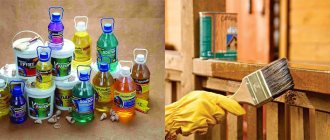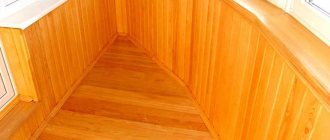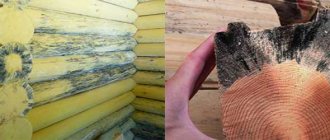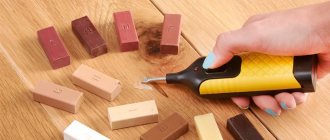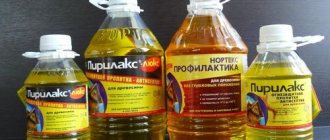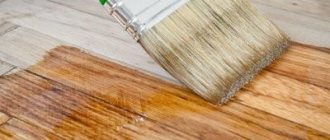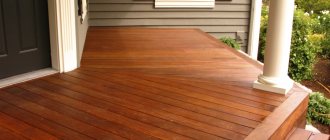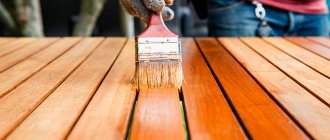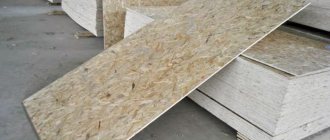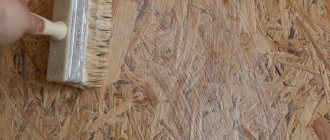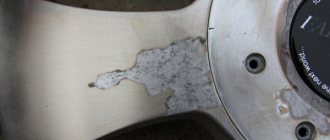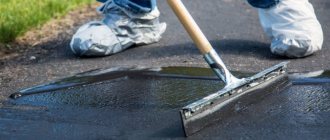Why does wood rot?
To effectively counteract wood decay, you need to understand the mechanism of this process. Rotting is caused by the activity of wood-decaying fungi. They are lower plants that are not able to convert minerals into organic substances, and are forced to parasitize wood.
The source of food for mushrooms is cellulose, the main component of wood, which is nothing more than carbohydrates. They cannot assimilate it in its pure form. To make their carbohydrate meal digestible, mushrooms secrete enzymes that convert cellulose into water-soluble glucose. This process is accompanied by the decomposition of the main structural components of wood with the release of carbon dioxide and water. Without going into details, this is the process of rotting, leading to the complete destruction of wood.
There are more than 60 species of fungi that attack wood. They differ in varying degrees of aggressiveness, but their development requires the same conditions.
- The moisture content of the wood itself is 20% or higher.
- Air temperature – from 5 to 30°C.
- Mandatory access to oxygen, which is involved in a chain of chemical processes.
Protecting wood from rotting and moisture
To prevent wood rotting, you need to act in two directions:
I. Eliminate favorable conditions for the development of wood-decaying fungi (use only dry lumber and do not neglect constructive measures to protect wood from moisture).
II. The second direction in the fight against decay is the mandatory treatment of wood with antiseptics, which protect the material from fungi and other agents of biodamage.
Mushrooms are the main detractors of wood in wildlife, but they are far from the only ones. Biological agents of destruction also include: insects, bacteria, algae, mollusks and crustaceans.
Causes of rotting
The main enemy of wood is fungus, which causes it to rot. “Contamination” can occur as a result of improper storage and transportation. Active reproduction of microorganisms provokes a whole set of accompanying factors:
- High air humidity – up to 90%.
- Stagnation of oxygen.
- Exposure to moisture.
- Temperature changes and freezing.
- Prolonged contact with the soil.
Fungus on wood
Purchased antiseptics against moisture and rotting
Modern antiseptics are the best way to make wood resistant to fungi and insects. Today this is the simplest and most reliable option for treating wood against rotting. Such impregnations do not make wood moisture resistant (therefore waterproofing is very important), but they have a fungicidal property that prevents the development of unwanted bioactivity. Modern antiseptics have a broad effect and stop all types of wood rotting.
The process of decay depends on external conditions. The development of fungi stops at low temperatures, but they do not die and are activated with the onset of heat. High temperatures (from 80°C) kill the mycelium, and at 120°C the spores themselves die. At the same time, heat treatment does not exclude subsequent infection. Also, wood does not rot if it is constantly under water, which is explained by the lack of oxygen.
Antiseptics are mineral and organic .
Most biocides on the market are mineral antiseptics, which are used in the form of aqueous solutions. Strong antiseptics (but at the same time more toxic) are sodium fluoride, zinc fluoride, and magnesium fluoride. The category of less toxic mineral antiseptics includes sodium tetraborate (borax), zinc chloride, potassium permanganate, sodium and potassium dichromate. Weak solutions - sodium fluoride, copper sulfate, table salt.
Organic antiseptics are more toxic than mineral ones, but at the same time, they are significantly more effective and much more durable. Not all products in this category are water soluble. To liquefy some compounds, organic solvents are needed, which makes their use on the farm less practical.
All this sounds complicated and very confusing, but ordinary consumers do not need to delve into the intricacies of chemistry to choose the right antiseptic. It is enough to remember that the entire variety of modern compositions can be divided into two groups.
The antiseptic is chosen taking into account the complexity of the conditions in which wooden structures are used. Green → yellow → orange → red shows the gradation of load conditions from the most favorable to extreme.
I. Surface protection antiseptics
They are used mainly for preventive treatment of wood. The active substances of such solutions penetrate the surface layers of wood to a depth of 2-3 mm and create a fungicidal barrier for biodegradation agents. The vast majority of products in this category are safe for people and animals. Despite their largely preventive purpose, surface antiseptics can be used as a means to stop rotting of already affected wood.
II. Deep penetration antiseptics (preservative)
Impregnations in this category are characterized by a high concentration of biocides, resistance to leaching, and the ability to penetrate deep into the structure of the wood. They are used to “treat” wooden structures damaged by blue stains, mold, insects and other biological agents. For prevention, critical building structures (roof rafters, floor beams, etc.), as well as elements that experience increased exposure to moisture (the lower crowns of log houses, floor joists, pillars buried in the ground, pier piles, etc.) are treated with preservative antiseptics. .
Read more about modern antiseptics and the intricacies of choosing them correctly in a separate article: Without mold rot and woodworms. All about modern wood bioprotection
Top best products for external wood treatment
| Brand | Characteristic | Price |
| Senezh (Russia) | High-class, difficult-to-wash compounds in 20 types, including whitening and renewing compounds, antiseptics for baths, homes and gazebos; protect from fire, pests and moisture, provides protection for more than 10 years! | from 380 rubles (5kg) |
| Belinka (Slovenia) | Natural and safe, highly effective products that protect against ultraviolet radiation, moisture, insects and fire, a wide range of products | from 400 rubles (1l) |
| Pinotex (Estonia) | Polymer-based products protect against mold and moisture, fungus and insects, and withstand sudden temperature changes, therefore they are optimal for external treatment | from 280 rubles (1 l) |
| Neomid (Russia) | Effective impregnation for home, bathhouses and wooden floors, protects the surface from moisture for 5-7 years, they produce special products for treating the ends, a good price-quality ratio | from 200 rubles (1 l) |
| Tikkurila (Finland) | Moisture-resistant products, create a thin protective film and provide reliable protection from precipitation, are distinguished by high quality and positive reviews | from 250 rubles (1l) |
| Aquatex (Russia) | Available in the form of a primer and impregnation, colorless and tinted versions (15 colors), protects against fungus, ultraviolet radiation and moisture, suitable for middle-class wood | from 200 rubles (1 l) |
| Sitex (Russia) | Suitable for any type of wood, protects logs from moisture, preserves the appearance of the structure for 10 years, colorless and tinted options (12 colors) | from 200 rubles (1 l) |
Antiseptic treatment with copper sulfate
Proven and reliable fungicidal agents include copper compounds. The most affordable antiseptic in this category is a solution of copper sulfate (copper sulfate). It is used to combat mold, putrefactive fungi and other agents of biodestruction. Fungicides of this group disrupt the biochemical processes in the cells of microorganisms, preventing their nutrition and, accordingly, reproduction. Antiseptic treatment with copper sulfate solution is carried out mostly for preventive purposes.
The advantages of this homemade and truly folk antiseptic are low cost, ease of processing, and relative safety. But at the same time, it also has significant drawbacks. Despite its generally quite high efficiency, the antiseptic is quickly washed out of the wood structure. For this reason, treating wood with copper sulfate solution is not the best option for structures exposed to moisture. It also changes the color of the wood and causes corrosion of metal fasteners.
Making your own antiseptic solution
Depending on the conditions in which the wood is used, different concentrations of the solution are used:
- for treating closed wooden structures, prepare a 3-5% solution (300-500 g of copper sulfate per 10 liters of water);
- for treating wood in bathhouses and basements, use a 10% solution (1000 g per 10 liters of water);
- to protect outdoor (closed) structures and elements in contact with the ground, prepare a 20% solution (2 kg of vitriol per 10 liters of water).
The antiseptic is mixed in a plastic or glass non-food container (!). For better solubility, water is preheated to 50-60°C. Vitriol is added in parts, gradually adding liquid and mixing thoroughly until the crystals are completely dissolved.
When diluted, the liquid acquires a green color: depending on the concentration of vitriol, the color depth can vary from slightly greenish to rich emerald. Weak solutions are almost invisible on the surface of the wood. For color indication and better control during application, a small amount of potassium permanganate (potassium permanganate) may be added. Wood is treated with a freshly prepared solution.
The antiseptic can only be applied to dry wood with a moisture content of at least 15%. Otherwise, the fungicide will not be able to properly absorb into the structure of the material. The solution is applied with a brush or spray method. Treated structures are protected from exposure to moisture and direct sunlight, allowing time for the antiseptic to be completely absorbed and dry.
Protecting wood from fire Along with bioprotection, it is important to protect wooden structures of the house from fire.
Both procedures are carried out simultaneously, since the method of applying most fire and bioprotective agents is the same. To prevent fire, special impregnations are used - fire retardants. You can kill two birds with one stone by using complex fire-bioprotective agents - they protect against fire and biological damage. Read more about the types of fire retardants and the intricacies of fire retardant treatment of wooden buildings in a separate article.
Folk remedies for impregnation
If the putrefactive process has not had time to grow significantly, folk remedies will help prevent further destruction of the tree:
- Silicate glue.
- Soda and vinegar.
- Potassium dichromate solution.
- Copper sulfate.
- Resin.
- Salt and boric acid.
The easiest way is to use silicate glue. It is necessary to dilute it with water, and apply the resulting solution to areas where biodegradation occurs. You can also treat the rotting areas with soda, and spray vinegar from a spray bottle on top.
Potassium dichromate is used by mixing in equal proportions with sulfuric acid. The resulting composition should be used to treat not only the boards on the street, but also up to 50 cm of the soil layer.
Another effective remedy for preventing wood rot is copper sulfate. To prepare the composition, take 100 g of the substance per 10 liters of water.
For external treatment, you can use resin, as well as a mixture of 1 kg of salt and 50 g of boric acid, which are stirred in 5 liters of boiling water. This composition must be applied to the wood several times, waiting a couple of hours so that the product has time to be absorbed.
Production of Swedish and Finnish compounds
Who, if not the Scandinavians - with their traditions of wooden house-building and not the easiest climate - knows better than others about methods of protection from moisture and rotting. The traditional Swedish paint Falu rödfärg and its Finnish counterpart Punamultamaali are a real source of national pride for residents of the European north. Naturally, these compositions received such recognition not only because of aesthetics. They are valued for their low cost, ease of manufacture and ability to protect wood from all the hardships of the northern climate. We talked about how to prepare Swedish paint and Finnish composition in a separate article.
Protecting wood with oil
Oil impregnation is one of the most ancient methods of preserving wood. Today oils are used more as a decorative finish, however, this does not discount their protective properties. Drying oil (boiled linseed oil), tung or Danish oil are best suited for these purposes. They not only enhance the natural beauty of wood, emphasizing its texture and color, but also create a moisture barrier. Liquid oil is absorbed into the structure of the wood, after which it polymerizes (hardens), forming an impenetrable hydrophobic layer over the entire surface. It protects against moisture and thereby prevents rotting.
Read more about what types of oils there are and how to work with them correctly in a separate article.
Once upon a time, deck boards of ships, beams of buildings and other critical structures were boiled in linseed oil. Today, this method of preservation cannot withstand competition with cheaper and more effective compounds. In modern construction, oils are used mainly for interior decoration, where the problem of rotting is not so pressing. For outdoor impregnation of wood, for example, decking boards and garden furniture, manufacturers offer special formulations containing antiseptic additives and modifiers that enhance hydrophobic properties.
One of the simplest and 100% environmentally friendly ways to modify oil is to combine it with wax. After treatment with this product, the surface looks more beautiful, but more importantly, the wax provides a reinforced hydrophobic barrier. The consistency of the preservative can be varied: from liquid impregnation to thick paste. You can read more about what oil wax is and how to prepare it yourself here.
No. 2. General principles for choosing wood preservatives
Regardless of what factor the product is aimed at combating, when choosing, pay attention to the following nuances:
- coating service life . The protective agent can last on the surface for about 2-5 years, and if the manufacturer indicates such numbers on the packaging, then he is probably not lying, but durability of 20-40 years should be treated with caution. Most likely, this is just a marketing ploy, and in small letters in an inconspicuous place on the packaging it will be indicated that such a period of protection is possible only when the product is applied by deep impregnation (this is an industrial technique) or if the composition is washed out, which is impossible to achieve;
- composition consumption. Often, cheap products are unpleasantly surprised by the increased consumption of the composition, which is why all their efficiency is reduced to nothing, so when purchasing, you should pay attention to the figures indicated by the manufacturers. The average consumption of bioprotective agents is 200-250 g/m2, but not 500-600 g/m2, which can be seen on the packaging of some inexpensive formulations. Such high consumption is typical only for fire retardant compounds;
- manufacturer's name . High-quality protective equipment can only be produced on high-tech production lines, which large enterprises with a well-known name can afford. For the sake of your peace of mind and guaranteed results, it is better to overpay a little;
- versatility _ Some companies offer complex products that supposedly protect wood from both fire and rot, and the active ingredients, according to manufacturers, only enhance each other’s effect. Experts say that even substances that may be in the same solution sometimes not only do not enhance each other’s effect, but also reduce protection;
- composition and certificate of conformity. The composition of protective agents includes a lot of substances, each of which has its own role, but attention should be paid to the base of the drug - these can be organic and inorganic substances. Inorganic substances, which include sodium and potassium bichromates, chloride, chromium and fluorine-containing compounds, copper and zinc salts, negatively affect humans, metals and the color of wood, and are therefore prohibited for use in Europe. Organic-based products are more effective and avoid negative health effects. Any protective product must have a certificate of conformity confirming its safety.
Using bitumen mastic
Wooden structures that are constantly in contact with the ground or located close to the ground require complete waterproofing. Any drooping antiseptic used in such extreme conditions, over time, partially or completely loses its biocidal properties due to leaching of the main active components. Therefore, where it is possible to sacrifice aesthetics in favor of maximum moisture protection, bitumen coatings are used.
In difficult conditions, a combined scheme protects better from rotting, when the wood is first treated with a penetrating antiseptic, and then sealed with bitumen mastic, which prevents the leaching of fungicidal components. Such protection is recommended, for example, for wooden posts located in the ground or floor joists in contact with the ground.
Bituminous mastic is used to treat not only hidden structures, but also some external structures, for example, the lower crowns of a wooden house. This does not look the best, but it is often simply necessary, for example, if the log house is built on a low base or in an area with very high humidity.
Burning wood to protect it from rotting
Protecting wood by “smoking” has been known since ancient times throughout the world. This method has retained its right to life in modern construction. Moreover, thanks to the revival of interest in the traditional Japanese technology Shou Sugi Ban (Shusugiban), wood preservation using fire has become a fashionable trend in wooden house building.
How Shou Sugi Ban technology is experiencing a new round of popularity around the world - read in a separate article.
The preservative properties of firing are simply explained. Charring neutralizes cellulose, the already mentioned food source for biodegradation agents. Thus, the upper layers become unsuitable for fungi, bacteria and woodworms. Also, a hydrophobic barrier is created on the surface of the wood, which prevents moisture from unburned layers of wood. In addition to this, the carbon shell protects the material from weathering and destruction under the influence of ultraviolet radiation.
